MBA Project: Strategic Management Analysis of Coles and Woolworths
VerifiedAdded on 2020/04/21
|27
|6311
|136
Report
AI Summary
This report provides a strategic management analysis of Coles and Woolworths, two leading retail organizations in Australia. The study examines their corporate strategies and how these strategies impact their competitive advantages within the industry. The report includes an executive summary, literature review exploring concepts of corporate strategy, theoretical perspectives of competitive advantage such as Porter's Generic Strategy and Resource-Based View. The methodology section details the case study approach and data collection methods. The findings section presents data analysis, reflecting on the implications. The report concludes with recommendations for both companies, emphasizing differentiation strategies and the use of grocery analytic tools to enhance their market positions. The report aims to highlight and explore the strategies employed by Coles and Woolworths to improve their competitive advantage, and provides recommendations for future strategic development.
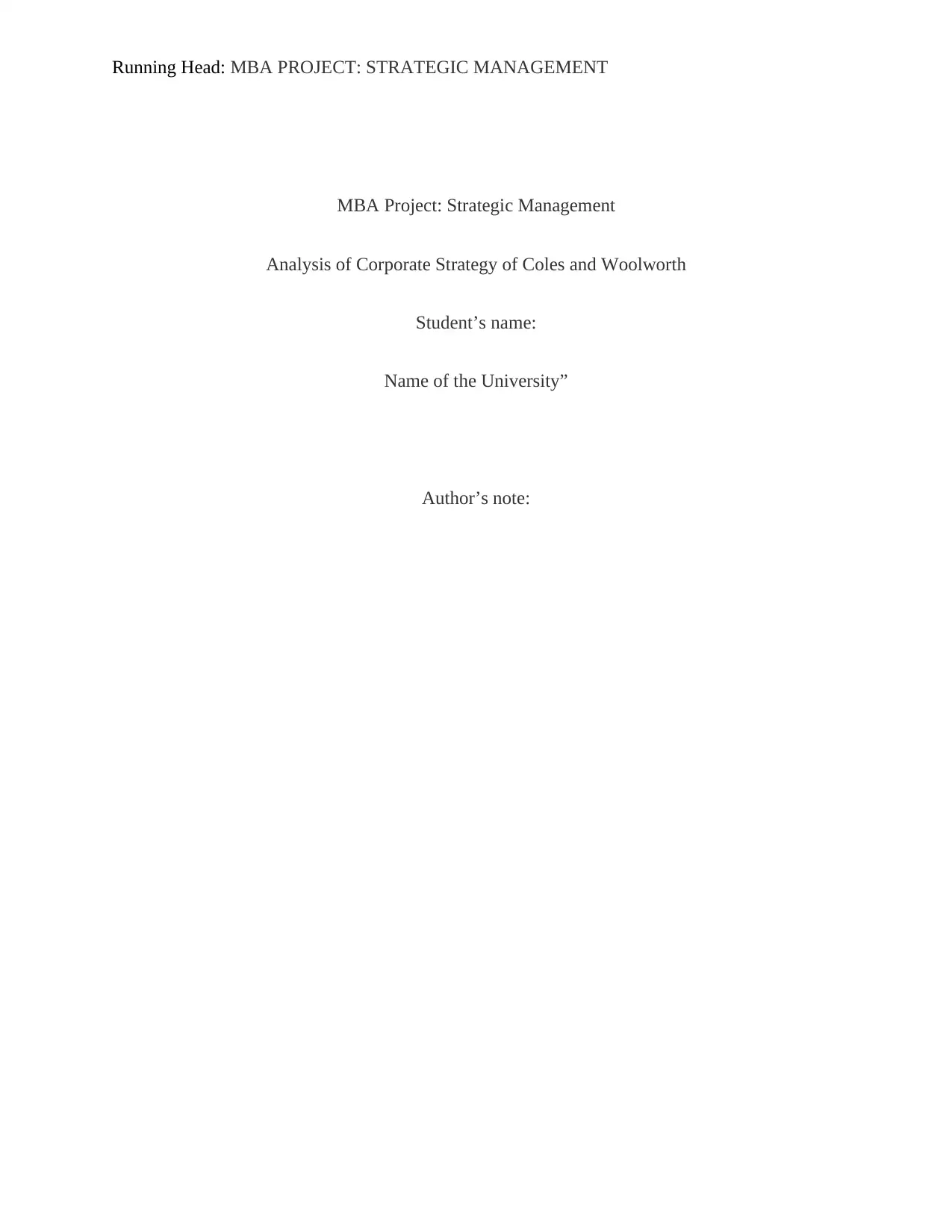
Running Head: MBA PROJECT: STRATEGIC MANAGEMENT
MBA Project: Strategic Management
Analysis of Corporate Strategy of Coles and Woolworth
Student’s name:
Name of the University”
Author’s note:
MBA Project: Strategic Management
Analysis of Corporate Strategy of Coles and Woolworth
Student’s name:
Name of the University”
Author’s note:
Paraphrase This Document
Need a fresh take? Get an instant paraphrase of this document with our AI Paraphraser
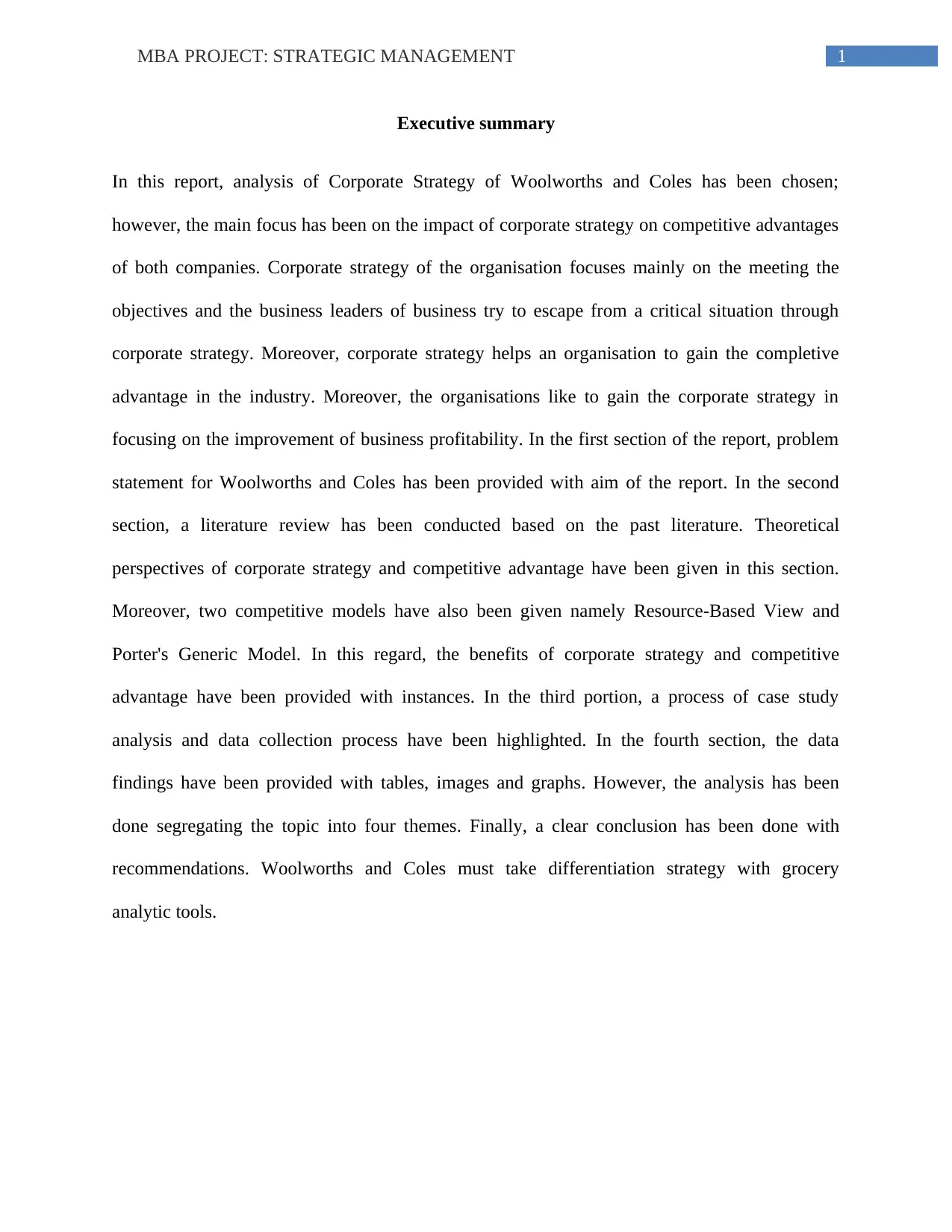
1MBA PROJECT: STRATEGIC MANAGEMENT
Executive summary
In this report, analysis of Corporate Strategy of Woolworths and Coles has been chosen;
however, the main focus has been on the impact of corporate strategy on competitive advantages
of both companies. Corporate strategy of the organisation focuses mainly on the meeting the
objectives and the business leaders of business try to escape from a critical situation through
corporate strategy. Moreover, corporate strategy helps an organisation to gain the completive
advantage in the industry. Moreover, the organisations like to gain the corporate strategy in
focusing on the improvement of business profitability. In the first section of the report, problem
statement for Woolworths and Coles has been provided with aim of the report. In the second
section, a literature review has been conducted based on the past literature. Theoretical
perspectives of corporate strategy and competitive advantage have been given in this section.
Moreover, two competitive models have also been given namely Resource-Based View and
Porter's Generic Model. In this regard, the benefits of corporate strategy and competitive
advantage have been provided with instances. In the third portion, a process of case study
analysis and data collection process have been highlighted. In the fourth section, the data
findings have been provided with tables, images and graphs. However, the analysis has been
done segregating the topic into four themes. Finally, a clear conclusion has been done with
recommendations. Woolworths and Coles must take differentiation strategy with grocery
analytic tools.
Executive summary
In this report, analysis of Corporate Strategy of Woolworths and Coles has been chosen;
however, the main focus has been on the impact of corporate strategy on competitive advantages
of both companies. Corporate strategy of the organisation focuses mainly on the meeting the
objectives and the business leaders of business try to escape from a critical situation through
corporate strategy. Moreover, corporate strategy helps an organisation to gain the completive
advantage in the industry. Moreover, the organisations like to gain the corporate strategy in
focusing on the improvement of business profitability. In the first section of the report, problem
statement for Woolworths and Coles has been provided with aim of the report. In the second
section, a literature review has been conducted based on the past literature. Theoretical
perspectives of corporate strategy and competitive advantage have been given in this section.
Moreover, two competitive models have also been given namely Resource-Based View and
Porter's Generic Model. In this regard, the benefits of corporate strategy and competitive
advantage have been provided with instances. In the third portion, a process of case study
analysis and data collection process have been highlighted. In the fourth section, the data
findings have been provided with tables, images and graphs. However, the analysis has been
done segregating the topic into four themes. Finally, a clear conclusion has been done with
recommendations. Woolworths and Coles must take differentiation strategy with grocery
analytic tools.
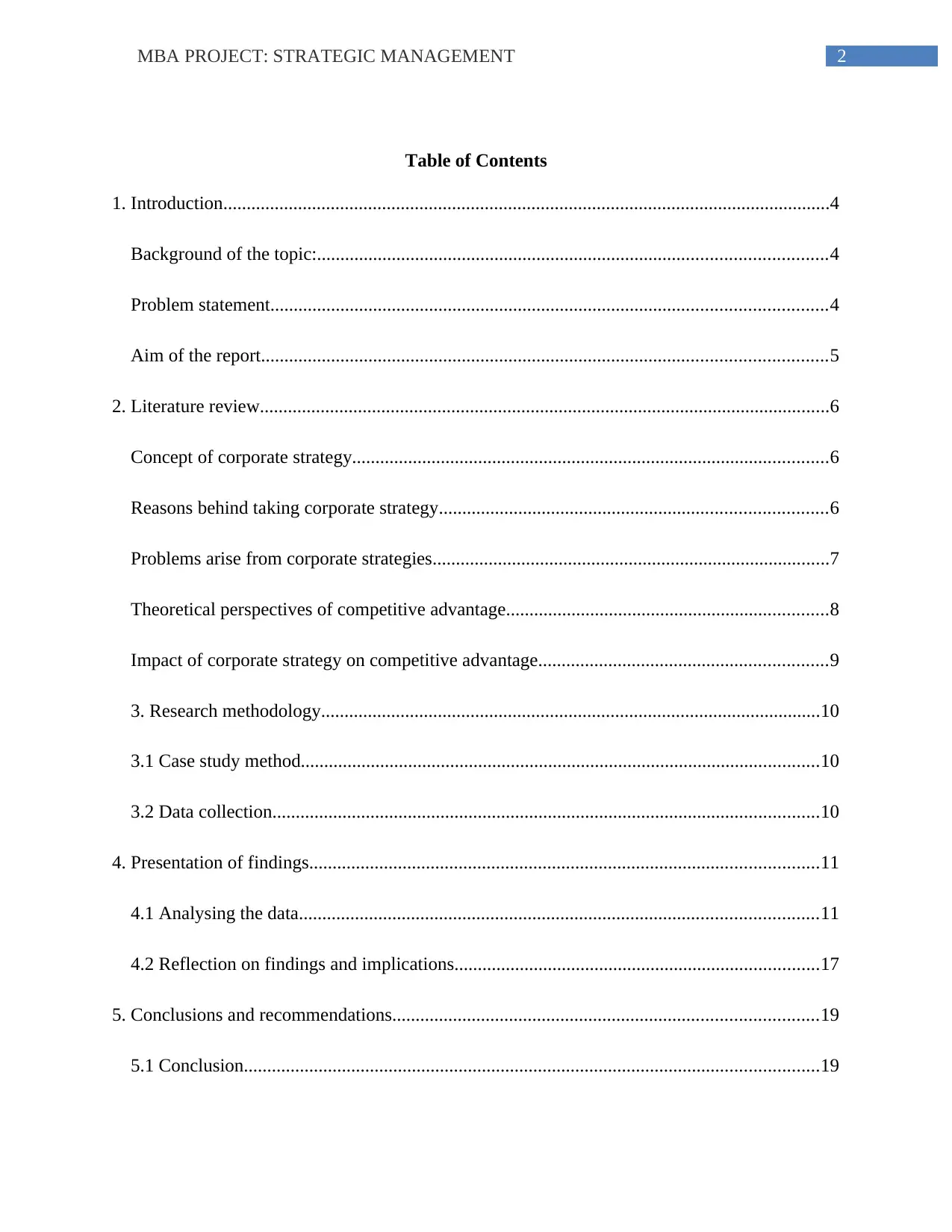
2MBA PROJECT: STRATEGIC MANAGEMENT
Table of Contents
1. Introduction..................................................................................................................................4
Background of the topic:.............................................................................................................4
Problem statement.......................................................................................................................4
Aim of the report.........................................................................................................................5
2. Literature review..........................................................................................................................6
Concept of corporate strategy......................................................................................................6
Reasons behind taking corporate strategy...................................................................................6
Problems arise from corporate strategies.....................................................................................7
Theoretical perspectives of competitive advantage.....................................................................8
Impact of corporate strategy on competitive advantage..............................................................9
3. Research methodology...........................................................................................................10
3.1 Case study method...............................................................................................................10
3.2 Data collection.....................................................................................................................10
4. Presentation of findings.............................................................................................................11
4.1 Analysing the data...............................................................................................................11
4.2 Reflection on findings and implications..............................................................................17
5. Conclusions and recommendations...........................................................................................19
5.1 Conclusion...........................................................................................................................19
Table of Contents
1. Introduction..................................................................................................................................4
Background of the topic:.............................................................................................................4
Problem statement.......................................................................................................................4
Aim of the report.........................................................................................................................5
2. Literature review..........................................................................................................................6
Concept of corporate strategy......................................................................................................6
Reasons behind taking corporate strategy...................................................................................6
Problems arise from corporate strategies.....................................................................................7
Theoretical perspectives of competitive advantage.....................................................................8
Impact of corporate strategy on competitive advantage..............................................................9
3. Research methodology...........................................................................................................10
3.1 Case study method...............................................................................................................10
3.2 Data collection.....................................................................................................................10
4. Presentation of findings.............................................................................................................11
4.1 Analysing the data...............................................................................................................11
4.2 Reflection on findings and implications..............................................................................17
5. Conclusions and recommendations...........................................................................................19
5.1 Conclusion...........................................................................................................................19
⊘ This is a preview!⊘
Do you want full access?
Subscribe today to unlock all pages.

Trusted by 1+ million students worldwide
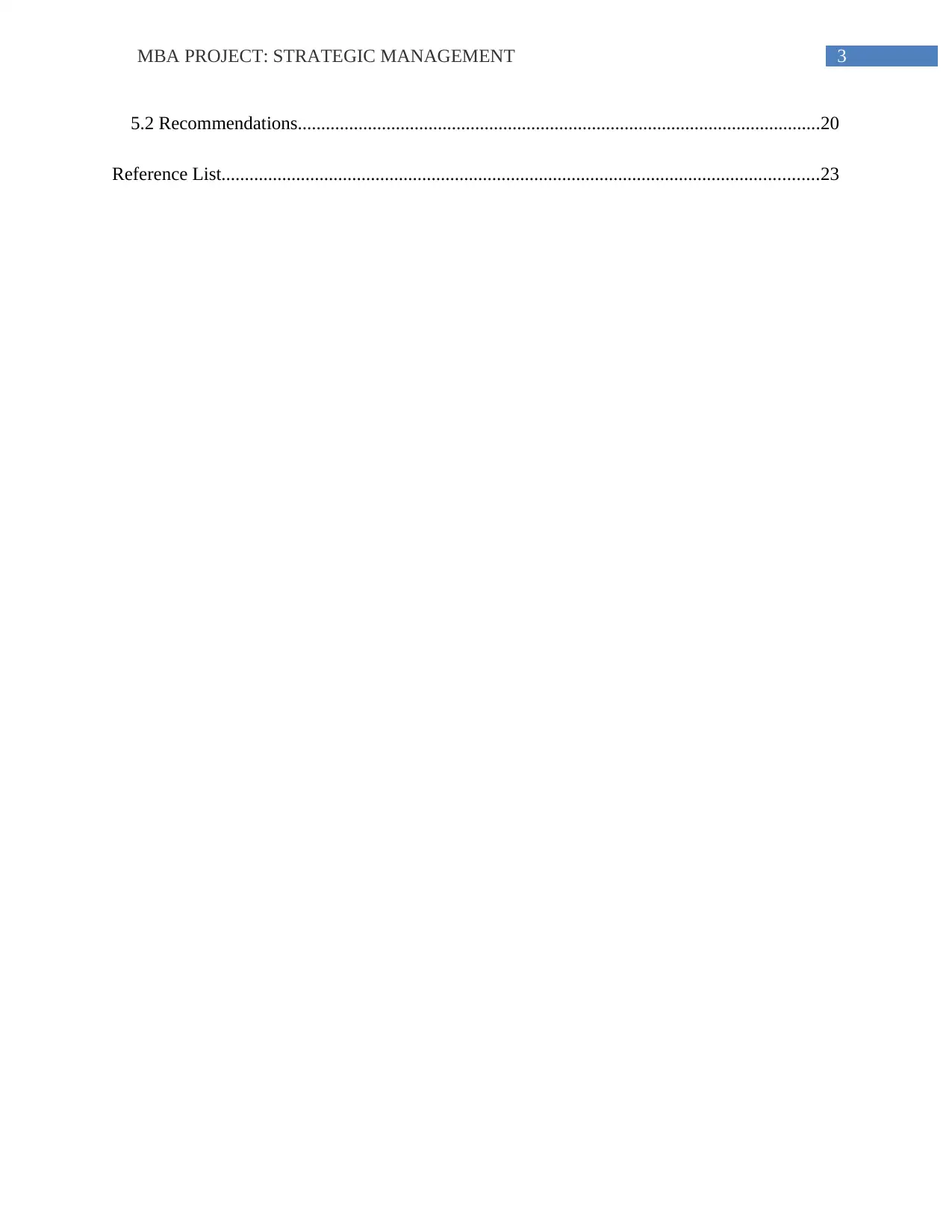
3MBA PROJECT: STRATEGIC MANAGEMENT
5.2 Recommendations................................................................................................................20
Reference List................................................................................................................................23
5.2 Recommendations................................................................................................................20
Reference List................................................................................................................................23
Paraphrase This Document
Need a fresh take? Get an instant paraphrase of this document with our AI Paraphraser
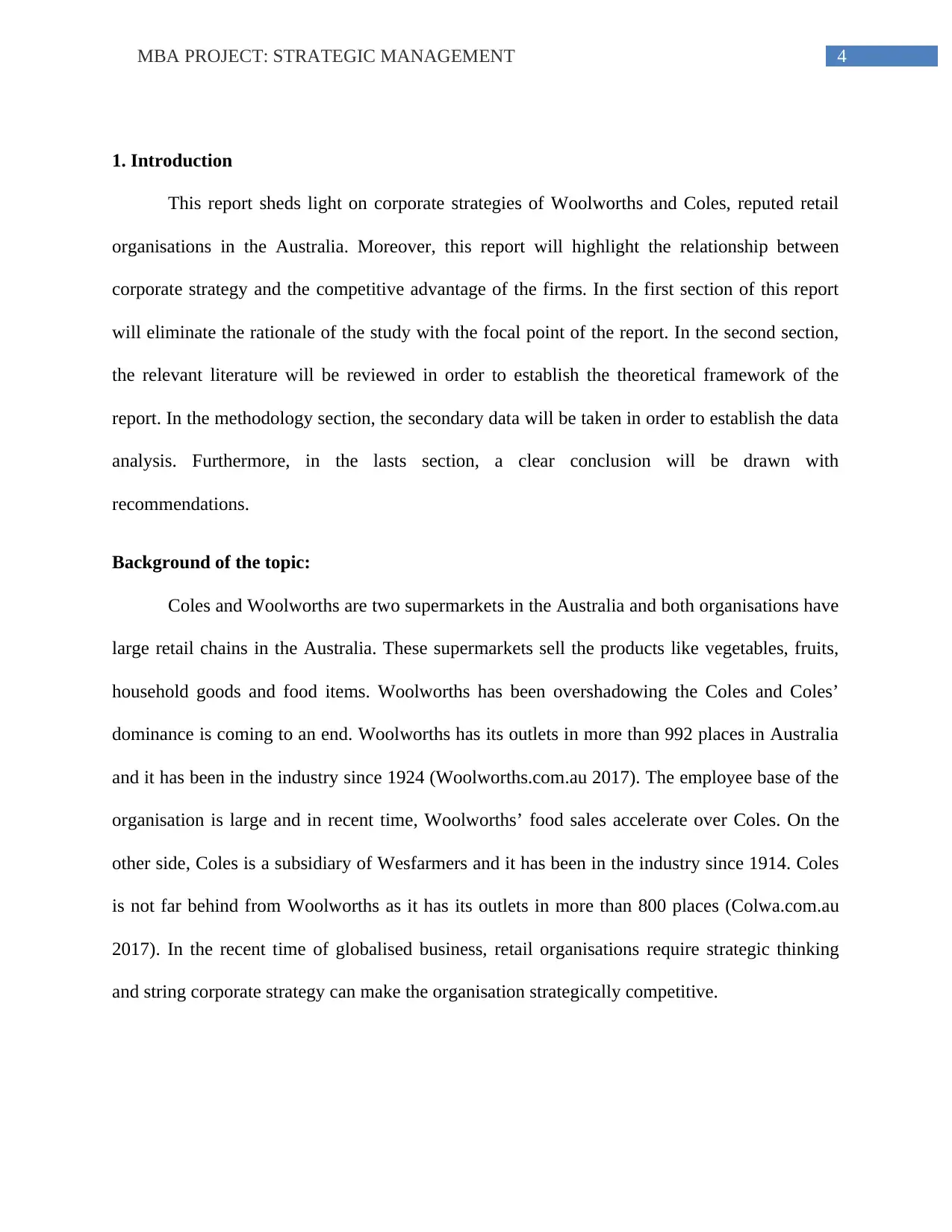
4MBA PROJECT: STRATEGIC MANAGEMENT
1. Introduction
This report sheds light on corporate strategies of Woolworths and Coles, reputed retail
organisations in the Australia. Moreover, this report will highlight the relationship between
corporate strategy and the competitive advantage of the firms. In the first section of this report
will eliminate the rationale of the study with the focal point of the report. In the second section,
the relevant literature will be reviewed in order to establish the theoretical framework of the
report. In the methodology section, the secondary data will be taken in order to establish the data
analysis. Furthermore, in the lasts section, a clear conclusion will be drawn with
recommendations.
Background of the topic:
Coles and Woolworths are two supermarkets in the Australia and both organisations have
large retail chains in the Australia. These supermarkets sell the products like vegetables, fruits,
household goods and food items. Woolworths has been overshadowing the Coles and Coles’
dominance is coming to an end. Woolworths has its outlets in more than 992 places in Australia
and it has been in the industry since 1924 (Woolworths.com.au 2017). The employee base of the
organisation is large and in recent time, Woolworths’ food sales accelerate over Coles. On the
other side, Coles is a subsidiary of Wesfarmers and it has been in the industry since 1914. Coles
is not far behind from Woolworths as it has its outlets in more than 800 places (Colwa.com.au
2017). In the recent time of globalised business, retail organisations require strategic thinking
and string corporate strategy can make the organisation strategically competitive.
1. Introduction
This report sheds light on corporate strategies of Woolworths and Coles, reputed retail
organisations in the Australia. Moreover, this report will highlight the relationship between
corporate strategy and the competitive advantage of the firms. In the first section of this report
will eliminate the rationale of the study with the focal point of the report. In the second section,
the relevant literature will be reviewed in order to establish the theoretical framework of the
report. In the methodology section, the secondary data will be taken in order to establish the data
analysis. Furthermore, in the lasts section, a clear conclusion will be drawn with
recommendations.
Background of the topic:
Coles and Woolworths are two supermarkets in the Australia and both organisations have
large retail chains in the Australia. These supermarkets sell the products like vegetables, fruits,
household goods and food items. Woolworths has been overshadowing the Coles and Coles’
dominance is coming to an end. Woolworths has its outlets in more than 992 places in Australia
and it has been in the industry since 1924 (Woolworths.com.au 2017). The employee base of the
organisation is large and in recent time, Woolworths’ food sales accelerate over Coles. On the
other side, Coles is a subsidiary of Wesfarmers and it has been in the industry since 1914. Coles
is not far behind from Woolworths as it has its outlets in more than 800 places (Colwa.com.au
2017). In the recent time of globalised business, retail organisations require strategic thinking
and string corporate strategy can make the organisation strategically competitive.
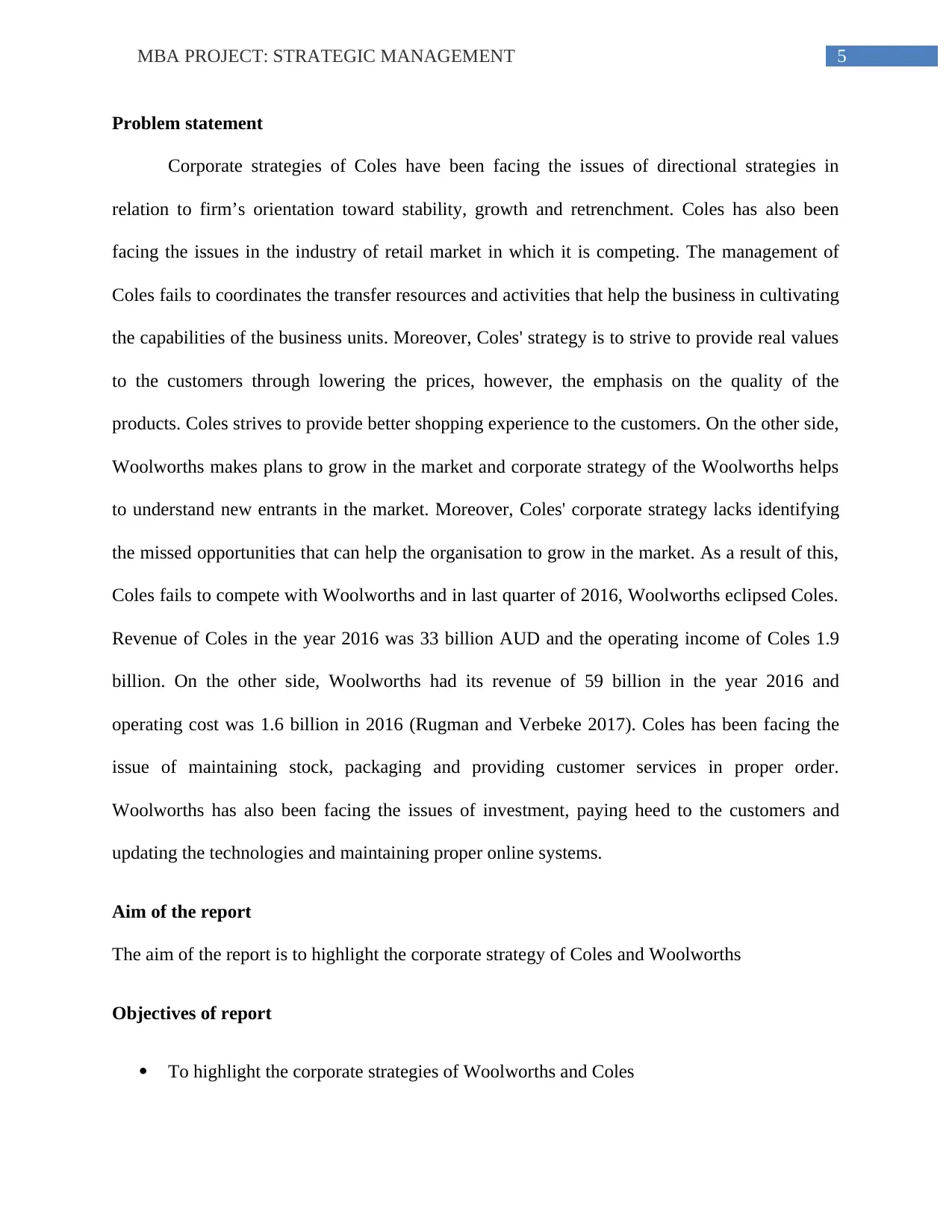
5MBA PROJECT: STRATEGIC MANAGEMENT
Problem statement
Corporate strategies of Coles have been facing the issues of directional strategies in
relation to firm’s orientation toward stability, growth and retrenchment. Coles has also been
facing the issues in the industry of retail market in which it is competing. The management of
Coles fails to coordinates the transfer resources and activities that help the business in cultivating
the capabilities of the business units. Moreover, Coles' strategy is to strive to provide real values
to the customers through lowering the prices, however, the emphasis on the quality of the
products. Coles strives to provide better shopping experience to the customers. On the other side,
Woolworths makes plans to grow in the market and corporate strategy of the Woolworths helps
to understand new entrants in the market. Moreover, Coles' corporate strategy lacks identifying
the missed opportunities that can help the organisation to grow in the market. As a result of this,
Coles fails to compete with Woolworths and in last quarter of 2016, Woolworths eclipsed Coles.
Revenue of Coles in the year 2016 was 33 billion AUD and the operating income of Coles 1.9
billion. On the other side, Woolworths had its revenue of 59 billion in the year 2016 and
operating cost was 1.6 billion in 2016 (Rugman and Verbeke 2017). Coles has been facing the
issue of maintaining stock, packaging and providing customer services in proper order.
Woolworths has also been facing the issues of investment, paying heed to the customers and
updating the technologies and maintaining proper online systems.
Aim of the report
The aim of the report is to highlight the corporate strategy of Coles and Woolworths
Objectives of report
To highlight the corporate strategies of Woolworths and Coles
Problem statement
Corporate strategies of Coles have been facing the issues of directional strategies in
relation to firm’s orientation toward stability, growth and retrenchment. Coles has also been
facing the issues in the industry of retail market in which it is competing. The management of
Coles fails to coordinates the transfer resources and activities that help the business in cultivating
the capabilities of the business units. Moreover, Coles' strategy is to strive to provide real values
to the customers through lowering the prices, however, the emphasis on the quality of the
products. Coles strives to provide better shopping experience to the customers. On the other side,
Woolworths makes plans to grow in the market and corporate strategy of the Woolworths helps
to understand new entrants in the market. Moreover, Coles' corporate strategy lacks identifying
the missed opportunities that can help the organisation to grow in the market. As a result of this,
Coles fails to compete with Woolworths and in last quarter of 2016, Woolworths eclipsed Coles.
Revenue of Coles in the year 2016 was 33 billion AUD and the operating income of Coles 1.9
billion. On the other side, Woolworths had its revenue of 59 billion in the year 2016 and
operating cost was 1.6 billion in 2016 (Rugman and Verbeke 2017). Coles has been facing the
issue of maintaining stock, packaging and providing customer services in proper order.
Woolworths has also been facing the issues of investment, paying heed to the customers and
updating the technologies and maintaining proper online systems.
Aim of the report
The aim of the report is to highlight the corporate strategy of Coles and Woolworths
Objectives of report
To highlight the corporate strategies of Woolworths and Coles
⊘ This is a preview!⊘
Do you want full access?
Subscribe today to unlock all pages.

Trusted by 1+ million students worldwide
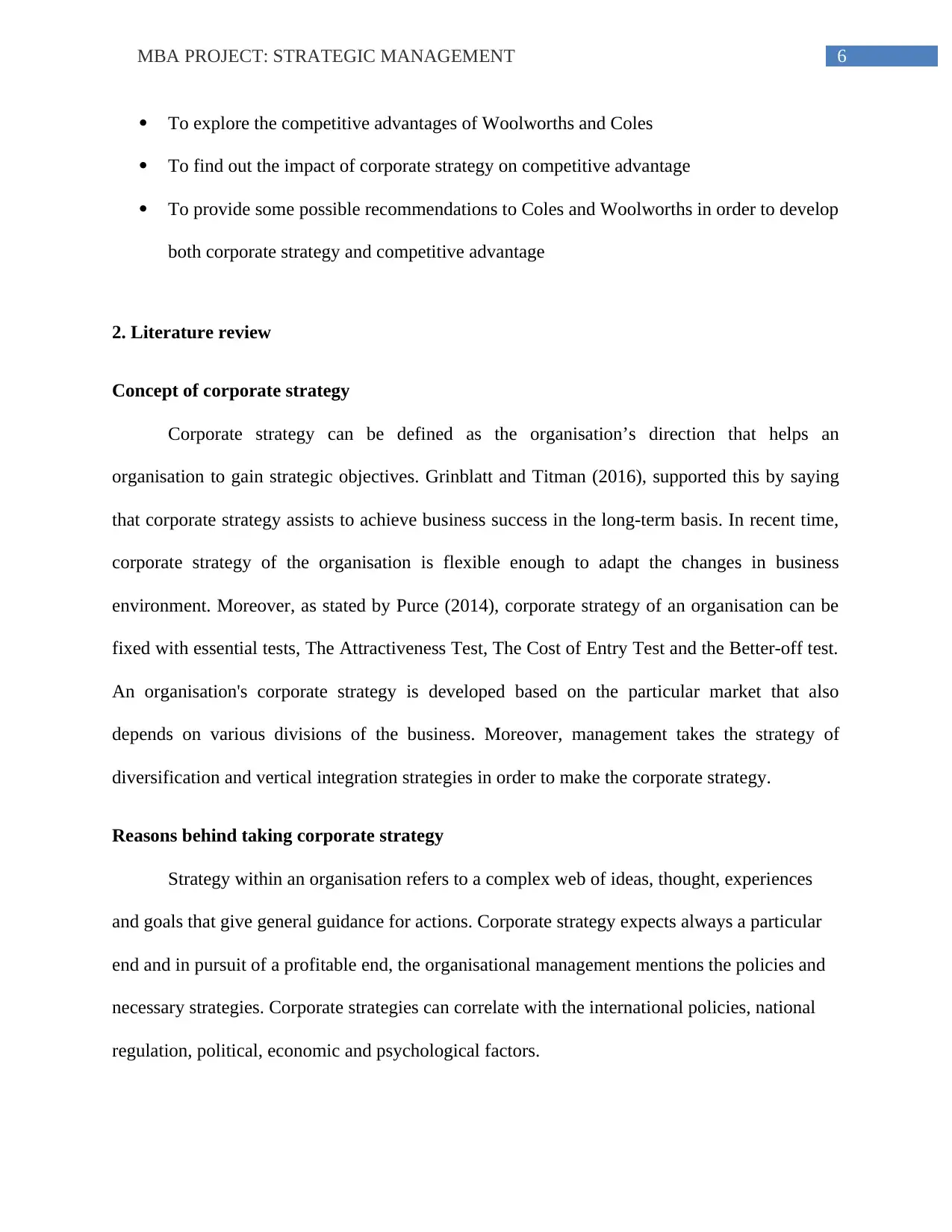
6MBA PROJECT: STRATEGIC MANAGEMENT
To explore the competitive advantages of Woolworths and Coles
To find out the impact of corporate strategy on competitive advantage
To provide some possible recommendations to Coles and Woolworths in order to develop
both corporate strategy and competitive advantage
2. Literature review
Concept of corporate strategy
Corporate strategy can be defined as the organisation’s direction that helps an
organisation to gain strategic objectives. Grinblatt and Titman (2016), supported this by saying
that corporate strategy assists to achieve business success in the long-term basis. In recent time,
corporate strategy of the organisation is flexible enough to adapt the changes in business
environment. Moreover, as stated by Purce (2014), corporate strategy of an organisation can be
fixed with essential tests, The Attractiveness Test, The Cost of Entry Test and the Better-off test.
An organisation's corporate strategy is developed based on the particular market that also
depends on various divisions of the business. Moreover, management takes the strategy of
diversification and vertical integration strategies in order to make the corporate strategy.
Reasons behind taking corporate strategy
Strategy within an organisation refers to a complex web of ideas, thought, experiences
and goals that give general guidance for actions. Corporate strategy expects always a particular
end and in pursuit of a profitable end, the organisational management mentions the policies and
necessary strategies. Corporate strategies can correlate with the international policies, national
regulation, political, economic and psychological factors.
To explore the competitive advantages of Woolworths and Coles
To find out the impact of corporate strategy on competitive advantage
To provide some possible recommendations to Coles and Woolworths in order to develop
both corporate strategy and competitive advantage
2. Literature review
Concept of corporate strategy
Corporate strategy can be defined as the organisation’s direction that helps an
organisation to gain strategic objectives. Grinblatt and Titman (2016), supported this by saying
that corporate strategy assists to achieve business success in the long-term basis. In recent time,
corporate strategy of the organisation is flexible enough to adapt the changes in business
environment. Moreover, as stated by Purce (2014), corporate strategy of an organisation can be
fixed with essential tests, The Attractiveness Test, The Cost of Entry Test and the Better-off test.
An organisation's corporate strategy is developed based on the particular market that also
depends on various divisions of the business. Moreover, management takes the strategy of
diversification and vertical integration strategies in order to make the corporate strategy.
Reasons behind taking corporate strategy
Strategy within an organisation refers to a complex web of ideas, thought, experiences
and goals that give general guidance for actions. Corporate strategy expects always a particular
end and in pursuit of a profitable end, the organisational management mentions the policies and
necessary strategies. Corporate strategies can correlate with the international policies, national
regulation, political, economic and psychological factors.
Paraphrase This Document
Need a fresh take? Get an instant paraphrase of this document with our AI Paraphraser
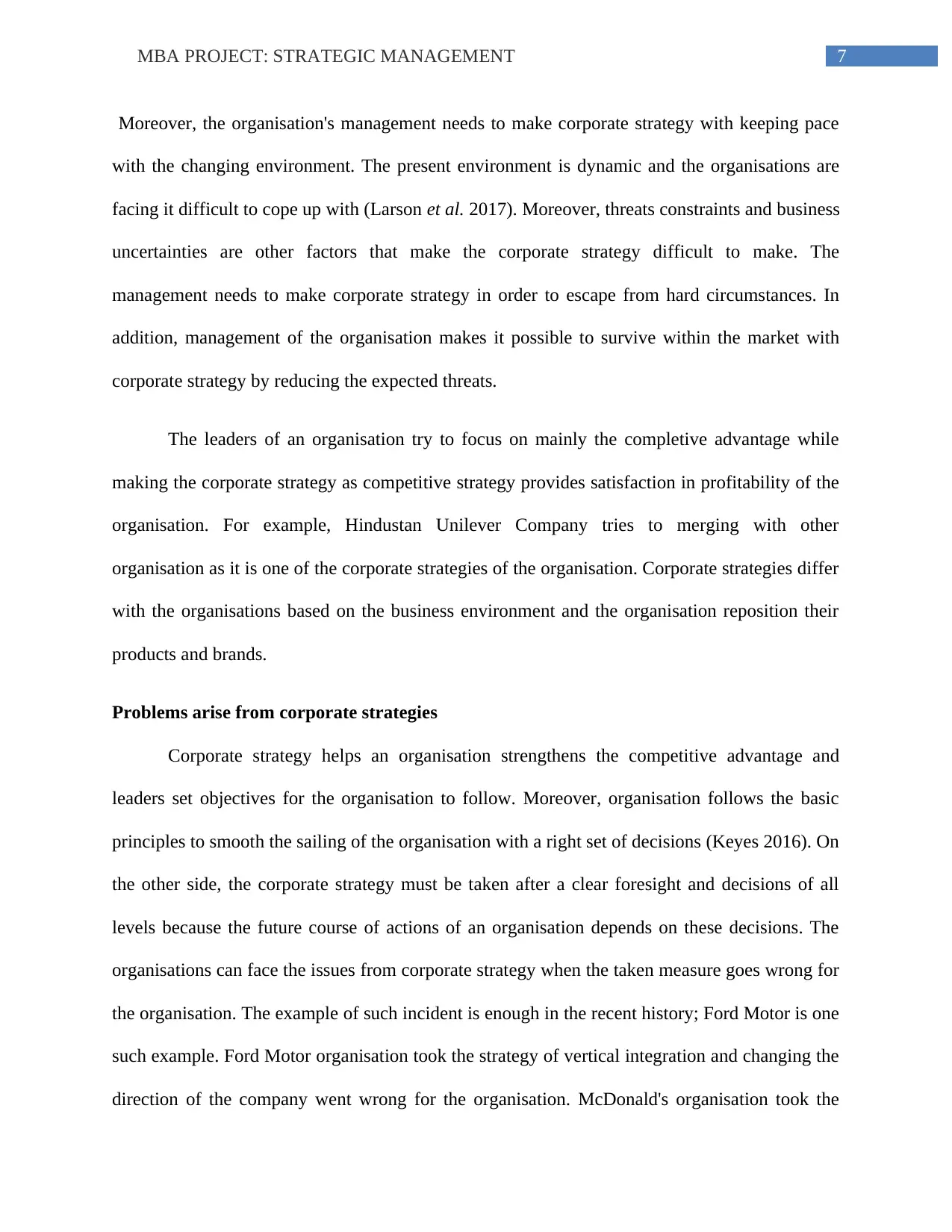
7MBA PROJECT: STRATEGIC MANAGEMENT
Moreover, the organisation's management needs to make corporate strategy with keeping pace
with the changing environment. The present environment is dynamic and the organisations are
facing it difficult to cope up with (Larson et al. 2017). Moreover, threats constraints and business
uncertainties are other factors that make the corporate strategy difficult to make. The
management needs to make corporate strategy in order to escape from hard circumstances. In
addition, management of the organisation makes it possible to survive within the market with
corporate strategy by reducing the expected threats.
The leaders of an organisation try to focus on mainly the completive advantage while
making the corporate strategy as competitive strategy provides satisfaction in profitability of the
organisation. For example, Hindustan Unilever Company tries to merging with other
organisation as it is one of the corporate strategies of the organisation. Corporate strategies differ
with the organisations based on the business environment and the organisation reposition their
products and brands.
Problems arise from corporate strategies
Corporate strategy helps an organisation strengthens the competitive advantage and
leaders set objectives for the organisation to follow. Moreover, organisation follows the basic
principles to smooth the sailing of the organisation with a right set of decisions (Keyes 2016). On
the other side, the corporate strategy must be taken after a clear foresight and decisions of all
levels because the future course of actions of an organisation depends on these decisions. The
organisations can face the issues from corporate strategy when the taken measure goes wrong for
the organisation. The example of such incident is enough in the recent history; Ford Motor is one
such example. Ford Motor organisation took the strategy of vertical integration and changing the
direction of the company went wrong for the organisation. McDonald's organisation took the
Moreover, the organisation's management needs to make corporate strategy with keeping pace
with the changing environment. The present environment is dynamic and the organisations are
facing it difficult to cope up with (Larson et al. 2017). Moreover, threats constraints and business
uncertainties are other factors that make the corporate strategy difficult to make. The
management needs to make corporate strategy in order to escape from hard circumstances. In
addition, management of the organisation makes it possible to survive within the market with
corporate strategy by reducing the expected threats.
The leaders of an organisation try to focus on mainly the completive advantage while
making the corporate strategy as competitive strategy provides satisfaction in profitability of the
organisation. For example, Hindustan Unilever Company tries to merging with other
organisation as it is one of the corporate strategies of the organisation. Corporate strategies differ
with the organisations based on the business environment and the organisation reposition their
products and brands.
Problems arise from corporate strategies
Corporate strategy helps an organisation strengthens the competitive advantage and
leaders set objectives for the organisation to follow. Moreover, organisation follows the basic
principles to smooth the sailing of the organisation with a right set of decisions (Keyes 2016). On
the other side, the corporate strategy must be taken after a clear foresight and decisions of all
levels because the future course of actions of an organisation depends on these decisions. The
organisations can face the issues from corporate strategy when the taken measure goes wrong for
the organisation. The example of such incident is enough in the recent history; Ford Motor is one
such example. Ford Motor organisation took the strategy of vertical integration and changing the
direction of the company went wrong for the organisation. McDonald's organisation took the
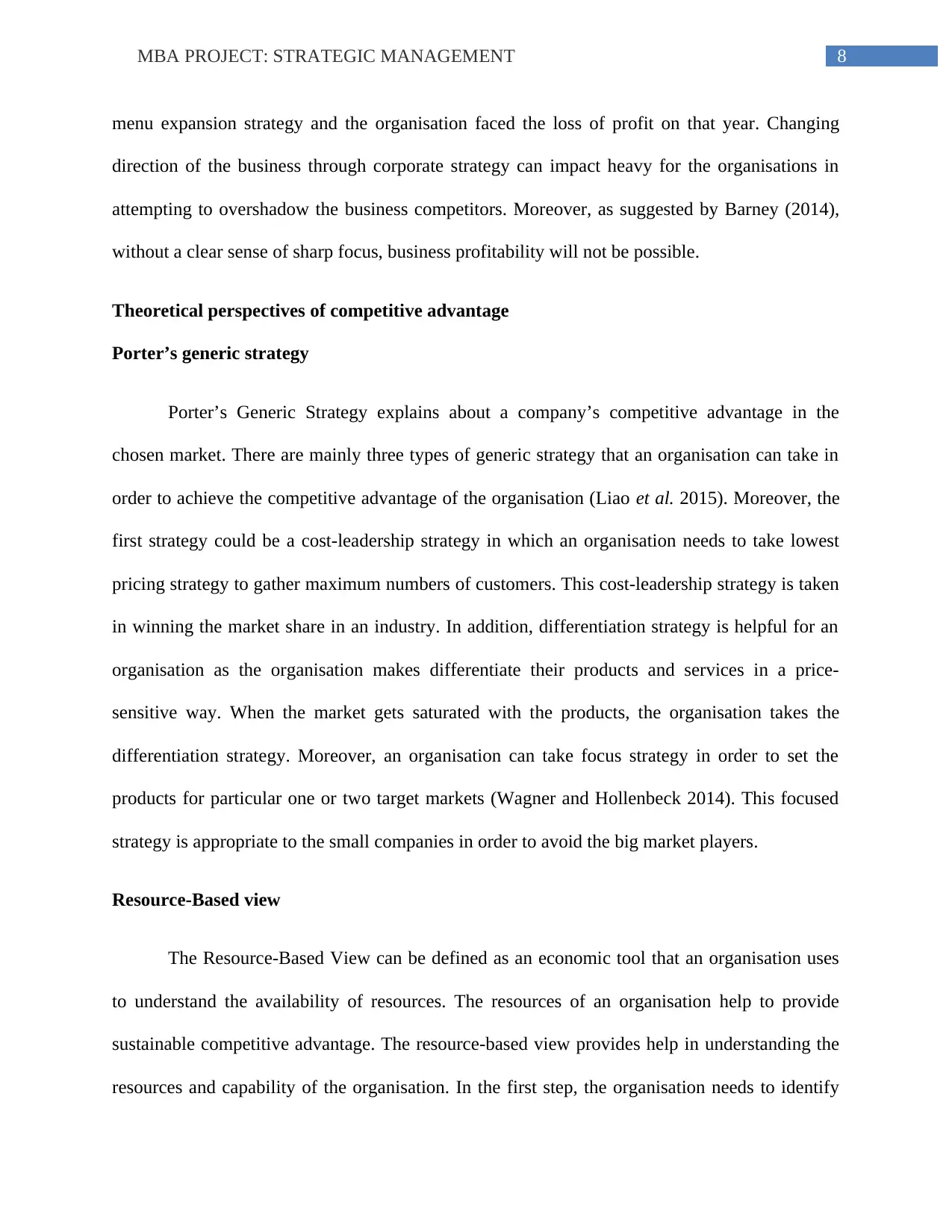
8MBA PROJECT: STRATEGIC MANAGEMENT
menu expansion strategy and the organisation faced the loss of profit on that year. Changing
direction of the business through corporate strategy can impact heavy for the organisations in
attempting to overshadow the business competitors. Moreover, as suggested by Barney (2014),
without a clear sense of sharp focus, business profitability will not be possible.
Theoretical perspectives of competitive advantage
Porter’s generic strategy
Porter’s Generic Strategy explains about a company’s competitive advantage in the
chosen market. There are mainly three types of generic strategy that an organisation can take in
order to achieve the competitive advantage of the organisation (Liao et al. 2015). Moreover, the
first strategy could be a cost-leadership strategy in which an organisation needs to take lowest
pricing strategy to gather maximum numbers of customers. This cost-leadership strategy is taken
in winning the market share in an industry. In addition, differentiation strategy is helpful for an
organisation as the organisation makes differentiate their products and services in a price-
sensitive way. When the market gets saturated with the products, the organisation takes the
differentiation strategy. Moreover, an organisation can take focus strategy in order to set the
products for particular one or two target markets (Wagner and Hollenbeck 2014). This focused
strategy is appropriate to the small companies in order to avoid the big market players.
Resource-Based view
The Resource-Based View can be defined as an economic tool that an organisation uses
to understand the availability of resources. The resources of an organisation help to provide
sustainable competitive advantage. The resource-based view provides help in understanding the
resources and capability of the organisation. In the first step, the organisation needs to identify
menu expansion strategy and the organisation faced the loss of profit on that year. Changing
direction of the business through corporate strategy can impact heavy for the organisations in
attempting to overshadow the business competitors. Moreover, as suggested by Barney (2014),
without a clear sense of sharp focus, business profitability will not be possible.
Theoretical perspectives of competitive advantage
Porter’s generic strategy
Porter’s Generic Strategy explains about a company’s competitive advantage in the
chosen market. There are mainly three types of generic strategy that an organisation can take in
order to achieve the competitive advantage of the organisation (Liao et al. 2015). Moreover, the
first strategy could be a cost-leadership strategy in which an organisation needs to take lowest
pricing strategy to gather maximum numbers of customers. This cost-leadership strategy is taken
in winning the market share in an industry. In addition, differentiation strategy is helpful for an
organisation as the organisation makes differentiate their products and services in a price-
sensitive way. When the market gets saturated with the products, the organisation takes the
differentiation strategy. Moreover, an organisation can take focus strategy in order to set the
products for particular one or two target markets (Wagner and Hollenbeck 2014). This focused
strategy is appropriate to the small companies in order to avoid the big market players.
Resource-Based view
The Resource-Based View can be defined as an economic tool that an organisation uses
to understand the availability of resources. The resources of an organisation help to provide
sustainable competitive advantage. The resource-based view provides help in understanding the
resources and capability of the organisation. In the first step, the organisation needs to identify
⊘ This is a preview!⊘
Do you want full access?
Subscribe today to unlock all pages.

Trusted by 1+ million students worldwide
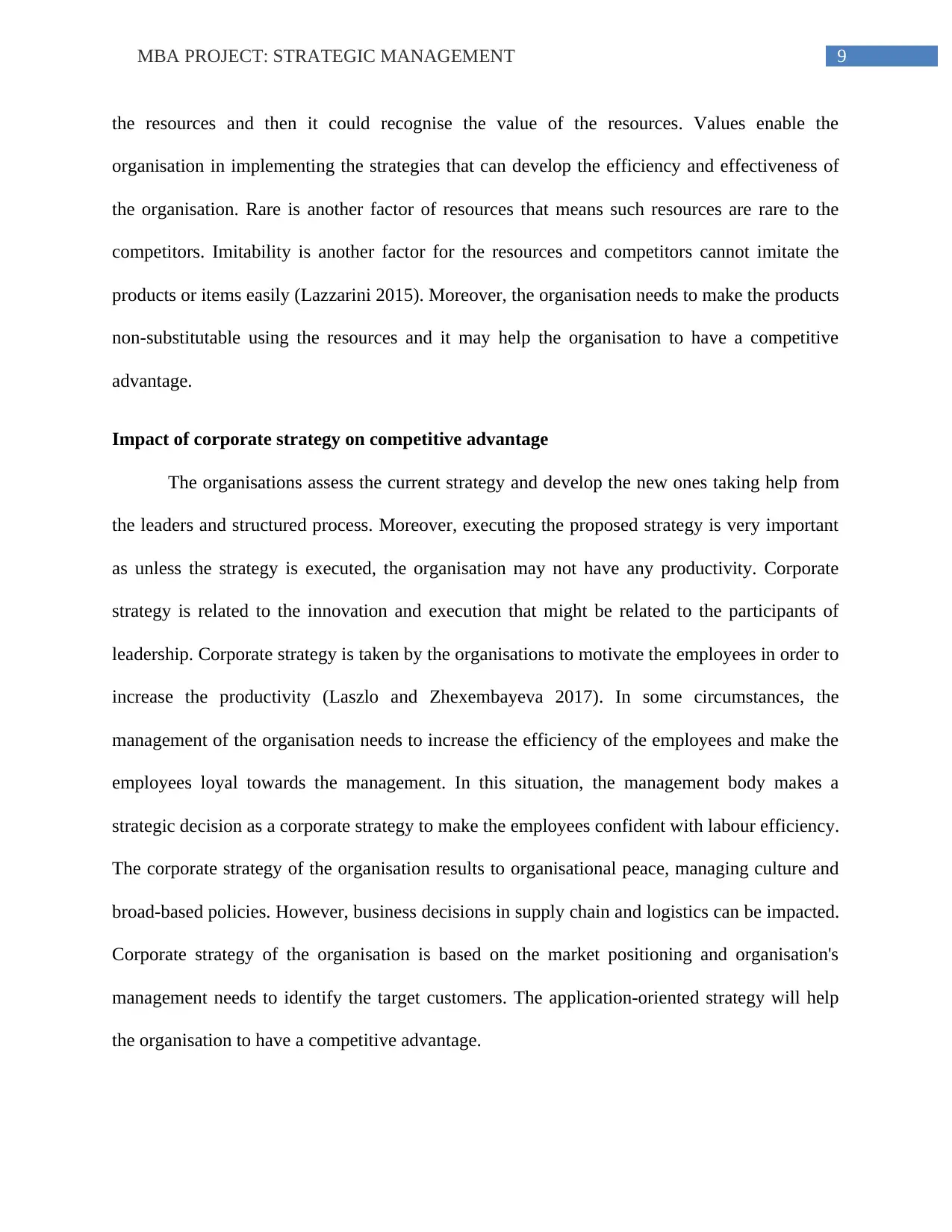
9MBA PROJECT: STRATEGIC MANAGEMENT
the resources and then it could recognise the value of the resources. Values enable the
organisation in implementing the strategies that can develop the efficiency and effectiveness of
the organisation. Rare is another factor of resources that means such resources are rare to the
competitors. Imitability is another factor for the resources and competitors cannot imitate the
products or items easily (Lazzarini 2015). Moreover, the organisation needs to make the products
non-substitutable using the resources and it may help the organisation to have a competitive
advantage.
Impact of corporate strategy on competitive advantage
The organisations assess the current strategy and develop the new ones taking help from
the leaders and structured process. Moreover, executing the proposed strategy is very important
as unless the strategy is executed, the organisation may not have any productivity. Corporate
strategy is related to the innovation and execution that might be related to the participants of
leadership. Corporate strategy is taken by the organisations to motivate the employees in order to
increase the productivity (Laszlo and Zhexembayeva 2017). In some circumstances, the
management of the organisation needs to increase the efficiency of the employees and make the
employees loyal towards the management. In this situation, the management body makes a
strategic decision as a corporate strategy to make the employees confident with labour efficiency.
The corporate strategy of the organisation results to organisational peace, managing culture and
broad-based policies. However, business decisions in supply chain and logistics can be impacted.
Corporate strategy of the organisation is based on the market positioning and organisation's
management needs to identify the target customers. The application-oriented strategy will help
the organisation to have a competitive advantage.
the resources and then it could recognise the value of the resources. Values enable the
organisation in implementing the strategies that can develop the efficiency and effectiveness of
the organisation. Rare is another factor of resources that means such resources are rare to the
competitors. Imitability is another factor for the resources and competitors cannot imitate the
products or items easily (Lazzarini 2015). Moreover, the organisation needs to make the products
non-substitutable using the resources and it may help the organisation to have a competitive
advantage.
Impact of corporate strategy on competitive advantage
The organisations assess the current strategy and develop the new ones taking help from
the leaders and structured process. Moreover, executing the proposed strategy is very important
as unless the strategy is executed, the organisation may not have any productivity. Corporate
strategy is related to the innovation and execution that might be related to the participants of
leadership. Corporate strategy is taken by the organisations to motivate the employees in order to
increase the productivity (Laszlo and Zhexembayeva 2017). In some circumstances, the
management of the organisation needs to increase the efficiency of the employees and make the
employees loyal towards the management. In this situation, the management body makes a
strategic decision as a corporate strategy to make the employees confident with labour efficiency.
The corporate strategy of the organisation results to organisational peace, managing culture and
broad-based policies. However, business decisions in supply chain and logistics can be impacted.
Corporate strategy of the organisation is based on the market positioning and organisation's
management needs to identify the target customers. The application-oriented strategy will help
the organisation to have a competitive advantage.
Paraphrase This Document
Need a fresh take? Get an instant paraphrase of this document with our AI Paraphraser
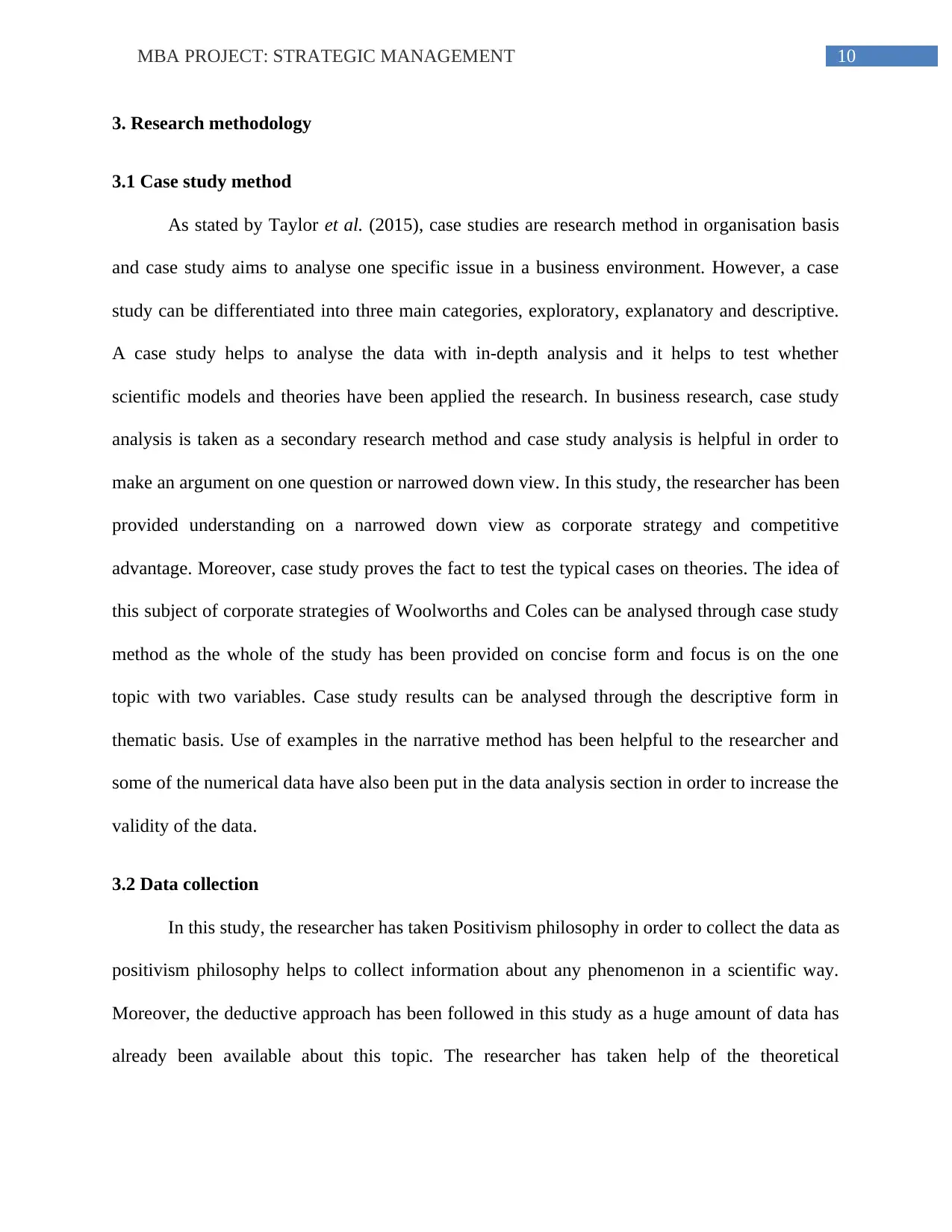
10MBA PROJECT: STRATEGIC MANAGEMENT
3. Research methodology
3.1 Case study method
As stated by Taylor et al. (2015), case studies are research method in organisation basis
and case study aims to analyse one specific issue in a business environment. However, a case
study can be differentiated into three main categories, exploratory, explanatory and descriptive.
A case study helps to analyse the data with in-depth analysis and it helps to test whether
scientific models and theories have been applied the research. In business research, case study
analysis is taken as a secondary research method and case study analysis is helpful in order to
make an argument on one question or narrowed down view. In this study, the researcher has been
provided understanding on a narrowed down view as corporate strategy and competitive
advantage. Moreover, case study proves the fact to test the typical cases on theories. The idea of
this subject of corporate strategies of Woolworths and Coles can be analysed through case study
method as the whole of the study has been provided on concise form and focus is on the one
topic with two variables. Case study results can be analysed through the descriptive form in
thematic basis. Use of examples in the narrative method has been helpful to the researcher and
some of the numerical data have also been put in the data analysis section in order to increase the
validity of the data.
3.2 Data collection
In this study, the researcher has taken Positivism philosophy in order to collect the data as
positivism philosophy helps to collect information about any phenomenon in a scientific way.
Moreover, the deductive approach has been followed in this study as a huge amount of data has
already been available about this topic. The researcher has taken help of the theoretical
3. Research methodology
3.1 Case study method
As stated by Taylor et al. (2015), case studies are research method in organisation basis
and case study aims to analyse one specific issue in a business environment. However, a case
study can be differentiated into three main categories, exploratory, explanatory and descriptive.
A case study helps to analyse the data with in-depth analysis and it helps to test whether
scientific models and theories have been applied the research. In business research, case study
analysis is taken as a secondary research method and case study analysis is helpful in order to
make an argument on one question or narrowed down view. In this study, the researcher has been
provided understanding on a narrowed down view as corporate strategy and competitive
advantage. Moreover, case study proves the fact to test the typical cases on theories. The idea of
this subject of corporate strategies of Woolworths and Coles can be analysed through case study
method as the whole of the study has been provided on concise form and focus is on the one
topic with two variables. Case study results can be analysed through the descriptive form in
thematic basis. Use of examples in the narrative method has been helpful to the researcher and
some of the numerical data have also been put in the data analysis section in order to increase the
validity of the data.
3.2 Data collection
In this study, the researcher has taken Positivism philosophy in order to collect the data as
positivism philosophy helps to collect information about any phenomenon in a scientific way.
Moreover, the deductive approach has been followed in this study as a huge amount of data has
already been available about this topic. The researcher has taken help of the theoretical
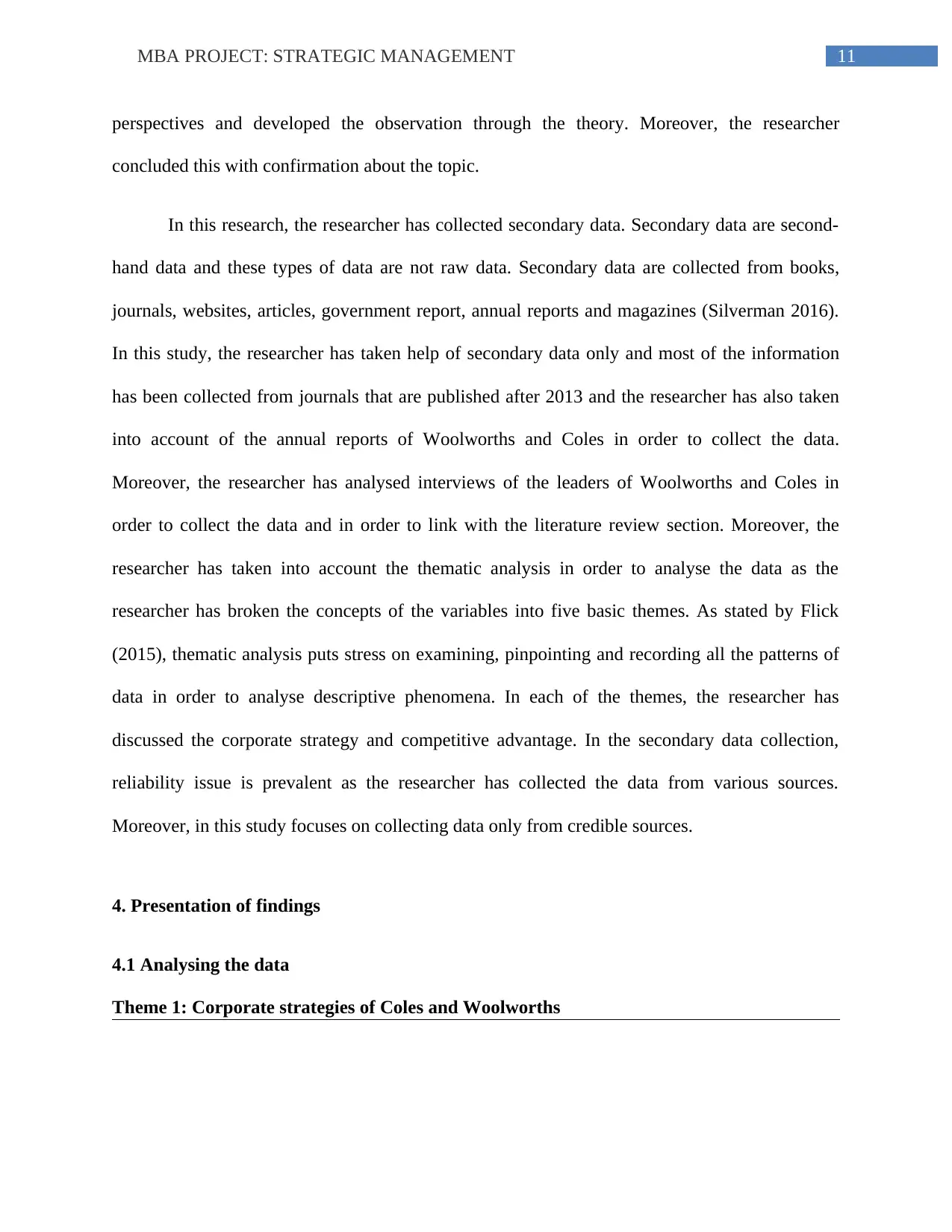
11MBA PROJECT: STRATEGIC MANAGEMENT
perspectives and developed the observation through the theory. Moreover, the researcher
concluded this with confirmation about the topic.
In this research, the researcher has collected secondary data. Secondary data are second-
hand data and these types of data are not raw data. Secondary data are collected from books,
journals, websites, articles, government report, annual reports and magazines (Silverman 2016).
In this study, the researcher has taken help of secondary data only and most of the information
has been collected from journals that are published after 2013 and the researcher has also taken
into account of the annual reports of Woolworths and Coles in order to collect the data.
Moreover, the researcher has analysed interviews of the leaders of Woolworths and Coles in
order to collect the data and in order to link with the literature review section. Moreover, the
researcher has taken into account the thematic analysis in order to analyse the data as the
researcher has broken the concepts of the variables into five basic themes. As stated by Flick
(2015), thematic analysis puts stress on examining, pinpointing and recording all the patterns of
data in order to analyse descriptive phenomena. In each of the themes, the researcher has
discussed the corporate strategy and competitive advantage. In the secondary data collection,
reliability issue is prevalent as the researcher has collected the data from various sources.
Moreover, in this study focuses on collecting data only from credible sources.
4. Presentation of findings
4.1 Analysing the data
Theme 1: Corporate strategies of Coles and Woolworths
perspectives and developed the observation through the theory. Moreover, the researcher
concluded this with confirmation about the topic.
In this research, the researcher has collected secondary data. Secondary data are second-
hand data and these types of data are not raw data. Secondary data are collected from books,
journals, websites, articles, government report, annual reports and magazines (Silverman 2016).
In this study, the researcher has taken help of secondary data only and most of the information
has been collected from journals that are published after 2013 and the researcher has also taken
into account of the annual reports of Woolworths and Coles in order to collect the data.
Moreover, the researcher has analysed interviews of the leaders of Woolworths and Coles in
order to collect the data and in order to link with the literature review section. Moreover, the
researcher has taken into account the thematic analysis in order to analyse the data as the
researcher has broken the concepts of the variables into five basic themes. As stated by Flick
(2015), thematic analysis puts stress on examining, pinpointing and recording all the patterns of
data in order to analyse descriptive phenomena. In each of the themes, the researcher has
discussed the corporate strategy and competitive advantage. In the secondary data collection,
reliability issue is prevalent as the researcher has collected the data from various sources.
Moreover, in this study focuses on collecting data only from credible sources.
4. Presentation of findings
4.1 Analysing the data
Theme 1: Corporate strategies of Coles and Woolworths
⊘ This is a preview!⊘
Do you want full access?
Subscribe today to unlock all pages.

Trusted by 1+ million students worldwide
1 out of 27
Related Documents
Your All-in-One AI-Powered Toolkit for Academic Success.
+13062052269
info@desklib.com
Available 24*7 on WhatsApp / Email
![[object Object]](/_next/static/media/star-bottom.7253800d.svg)
Unlock your academic potential
Copyright © 2020–2025 A2Z Services. All Rights Reserved. Developed and managed by ZUCOL.




